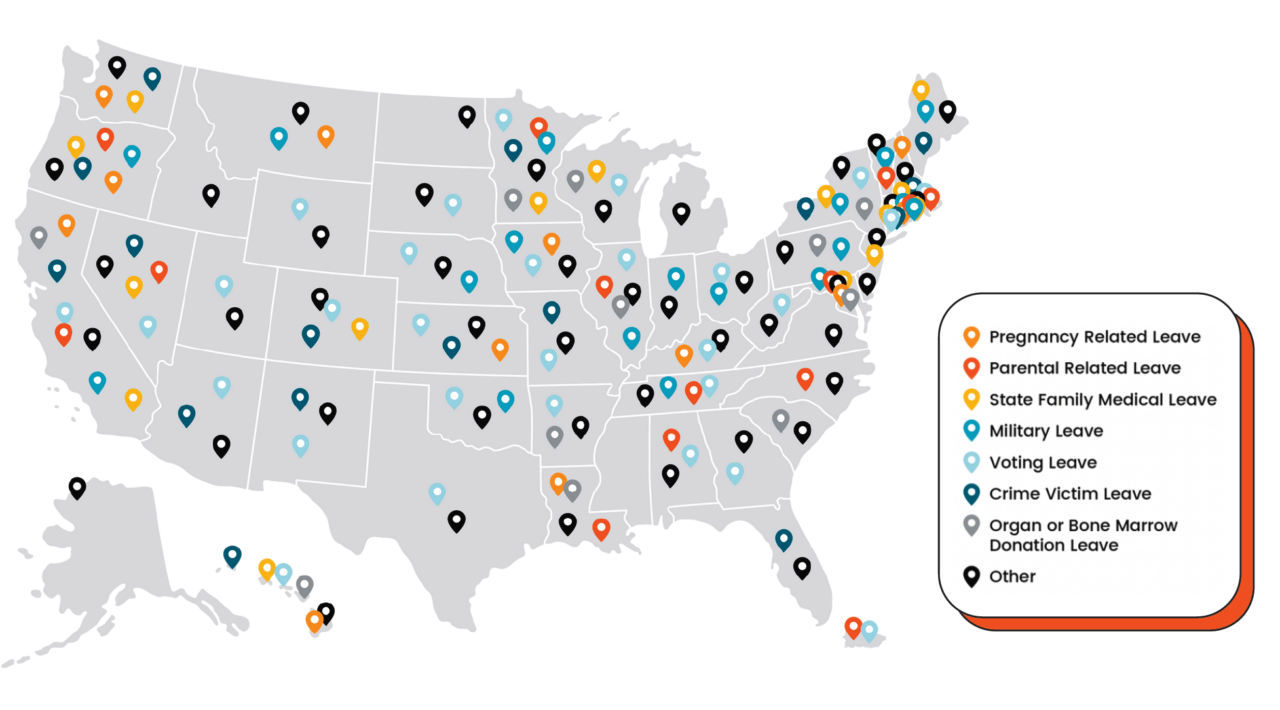Many organizations look to the Family and Medical Leave Act (FMLA) to provide employees with long-term, job-protected leaves of absence. The FMLA grants employees 12 weeks of job protection and unpaid leave for covered family or medical conditions. To be eligible, they must work at an employer with 50 or more employees located with 75 miles of their worksite. But what happens if an employee is not eligible for FMLA but still needs time away from work? How can you support them?
Why would an employee not be eligible for FMLA?
According to the US Department of Labor, employees are entitled to 12 weeks of FMLA leave for the following reasons:
- The birth of a child, and to care for the newborn child within one year of birth
- To care for a newly-placed adoptive or foster child (or children), within one year of placement
- To care for the employee’s family member including spouse, child, or parent who has a serious health condition
- A serious health condition that makes the employee unable to perform the essential functions of their job
- Any qualifying exigency due to the employee being qualified for military family leave. This means the employee has a spouse, son, daughter, or parent that is a covered military member on “covered active duty”
If an employee needs to go out on leave for any of the reasons mentioned above, they may apply for FMLA. However, to qualify for FMLA the employee must:
- Have worked at the organization for at least 12 months
- Worked at least 1,250 hours during the previous year
- Currently work at a location where there are at least 50 employees with a 75-mile radius

These requirements must be met for an employee to qualify for FMLA. If either the employee or employer fall short, then FMLA is not an option. When an employee isn’t qualified for FMLA, employers are not obligated to grant leave. However, when you support employees during their time of need, you provide a better experience for that employee, and make them more likely to return to work.
When FMLA isn’t an option, you should reach out to the employee to better understand of their situation. Then, you can work together to find out their needs are, and what options they might have. Below, we’ll look at what those alternative options could be.
State leave laws can provide alternative leave options
If an employee is not eligible for FMLA leave, the first thing you can do is look for state leave laws that this employee could be eligible for. However, there are over 130 leave laws in the United States that all change regularly. To best help your employees, it’s important that you have the most up to date information at your fingertips.
Each state has different eligibility requirements and benefits. Let’s look at Connecticut as an example. Connecticut employers are covered by the Connecticut Family and Medical Leave (CTFMLA) This law allows all Connecticut employers with one or more employees to offer their employees twelve weeks of time off.

However, if the same employee lived in New Jersey instead of Connecticut, their employer would need 30 employees to be considered a covered employer for New Jersey’s state paid leave laws. Some states have no additional leave laws, while states like Oregon have extremely robust and complex ones.
State leaves are not only all different from one another, but are constantly changing. Technology like AbsenceSoft allows HR to instantly view all the state policies any given employee would be eligible for. This allows you to provide options to employees not eligible for FMLA easier and faster.
Offering leave under the Americans with Disabilities Act (ADA)
In some cases, the ADA can be used to provide a leave of absence if FMLA leave isn’t an option. To offer this option, you need to make sure that the employee is eligible for ADA.
An employee is eligible for a workplace accommodation under the ADA if they have a qualifying disability. A qualifying disability is one that “substantially limits one or more major life activities.”
So, if an employee has a qualifying disability that is impacting their daily life, they could be eligible for a leave of absence. The leave must also be a reasonable accommodation, and not create an undue hardship for their employer. Typically, unpaid leave for a specified time period is considered reasonable. Offering a defined paid leave can also be considered a reasonable accommodation, depending on the employer.
Because the ADA is not as clearly defined as FMLA, it’s important to have a thorough interactive process with the employee. This way, both HR and the employee can effectively work together to find an accommodation that works for everyone. If you would like to learn more about ADA and the interactive process, check out our: Best Practice for Modern ADA and Accommodations Management Guide.
How the Pregnant Workers Fairness Act can support your employees
If you are trying to help a pregnant worker who is not eligible for FMLA, there is a new law that could support them before they give birth. The Pregnant Workers Fairness Act takes effect June 27, 2023, and requires that employers with at least 15 employees provide reasonable accommodations to employees with limitations related to pregnancy, the birth of a child, or related medical conditions.
PWFA is different from ADA because although some pregnancy-related conditions can qualify as a disability for ADA, they must cause “physical or mental impairment that substantially limits one or more major life activities of the individual.” The PWFA goes beyond ADA to ensure that pregnancy-related medical restrictions no longer must rise to the level of disability to warrant accommodation.
- Accommodations can come in many forms for pregnant workers, some of which include:
- Flexible work schedules
- Lighter workload
- Intermittent or extended leaves of absence
- Additional breaks
- More supportive seating
Company policies that provide leave as a benefit
A company’s own leave policies in place might also offer leave for employees who don’t qualify for FMLA. Your HR team can see if the employee is eligible for a company policy that offers either paid or unpaid leave.
According to AbsenceSoft’s 2023 Employee Leave of Absence Forecast Survey, 70% of respondents had either recently added or will be adding modernized leave benefits in 2023. Having leave policies that offer more generous leave benefits than FMLA improve employee retention and satisfaction.
The most important thing for your human resources team to keep in mind when an employee is not eligible for FMLA is to take the time to explore all of their options. If someone needs to go on leave to help their injured family member, or because they are injured themselves, it’s best to find a solution that can support them through a challenging time.
Having a leave management system like AbsenceSoft in place can make this process much easier. You will be able to calculate exactly what an employee is eligible at the click of a button. Our ADA module allows you guidance through the interactive process, so you make sure you are checking all the boxes. If you are interested in learning more about how AbsenceSoft can help your team, our leave experts would be happy to chat.

